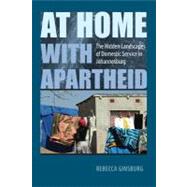At Home With Apartheid
, by Ginsburg, Rebecca- ISBN: 9780813928883 | 0813928885
- Cover: Hardcover
- Copyright: 9/30/2011
Despite their peaceful, bucolic appearance, the tree-lined streets of South African suburbia were no refuge from the racial tensions and indignities of apartheid's most repressive years. In At Home with Apartheid, Rebecca Ginsburg provides an intimate examination of the cultural landscapes of Johannesburg's middle- and upper-middle-class neighborhoods during the height of apartheid (c. 1960-1975) and incorporates recent scholarship on gender, the home, and family. More subtly but no less significantly than factory floors, squatter camps, prisons, and courtrooms, the homes of white South Africans were sites of important contests between white privilege and black aspiration. Subtle negotiations within the domestic sphere between white, mostly female, householders and their black domestic workers, also primarily women, played out over and around this space. These seemingly mundane, private conflicts were part of larger contemporary struggles between whites and blacks over territory and power. Ginsburg gives special attention to the distinct social and racial geographies produced by the workers' detached living quarters, designed by builders and architects as landscape complements to the main houses. Ranch houses, Italianate villas, modernist cubes, and Victorian bungalows filled Johannesburg's suburbs. What distinguished these neighborhoods from their precedents in the United States or the United Kingdom was the presence of the ubiquitous back rooms and of the African women who inhabited them in these otherwise exclusively white areas. The author conducted more than seventy-five personal interviews for this book, an approach that sets it apart from other architectural histories. In addition to these oral accounts, Ginsburg draws from plans, drawings, and onsite analysis of the physical properties themselves. While the issues addressed span the disciplines of South African and architectural history, feminist studies, material culture studies, and psychology, the book's strong narrative, powerful oral histories, and compelling subject matter bring the neighborhoods and residents it examines vividly to life.







